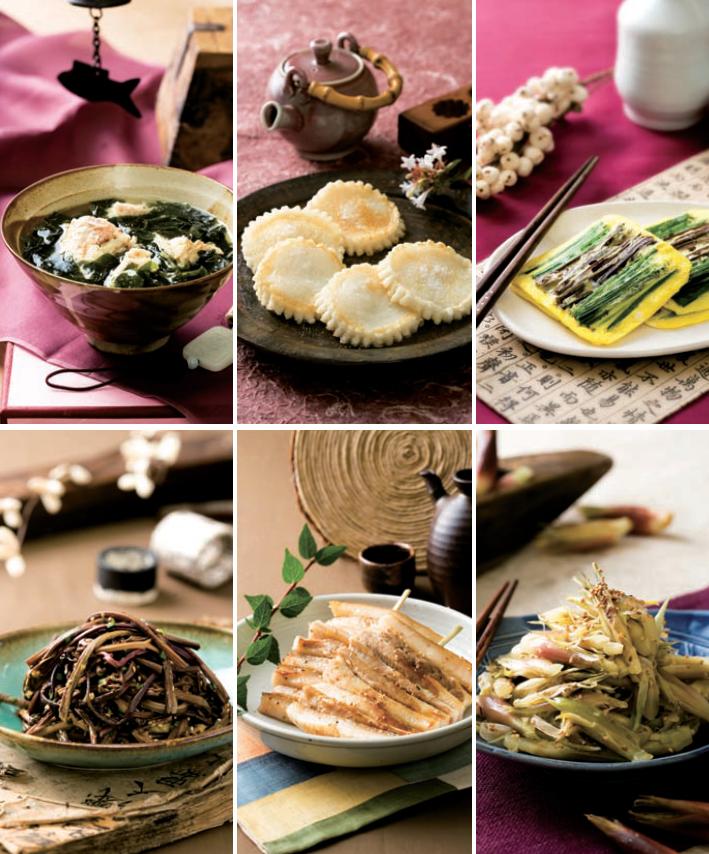| |
 |
|
| ▲ Six beautiful examples of Charye food. From top left, seaweed and fish gaeng, star-shaped ujjik, neureumjeon, gosari chae, pork jeok, and yangha chae. Photos courtesy Agricultural Research and Extension Services of Jeju Special Self-Governing Province |
Chuseok, the Harvest Moon Festival, is celebrated on the 15th day of the eighth month of the lunar calendar, or eumryeok, sometime during September or early October. The holiday is observed over three days and has been compared to Thanksgiving.
This year we are treated to a five-day break as Chuseok falls on Thursday Sept. 19, straddled by holidays on Sept. Wednesday 18 and Friday 20. For Koreans, it is a time for hometown, family and food!
It is the most important Korean holiday and has been celebrated for hundreds of years. In archaic Korean it was called Hangawi, meaning “great middle,” and Chuseok means “mid-autumn” in Chinese, both referring to the autumn full moon.
Some scholars believe it started 2,000 years ago during the reign of Shilla-era King Euri when a national contest was organized to boost the weaving industry. Other scholars believe that Chuseok originated from shamanic harvest moon celebrations. In the modern age, while being a time to honor ancestors, it is also a harvest festival.
Families spend the day before Chuseok traveling to their hometowns, while the day after Chuseok is for rest and cleaning up. Chuseok has many traditions and customs, and much of the holiday is centered around food, which will now be introduced.
Charye food
On Chuseok morning, families perform a “charye,” a memorial service for their ancestors. Families then gather at the table for a feast of foods that symbolize their respect for family members that have passed away.
The food eaten differs according to region. Rice was scarce in Jeju, so barley, buckwheat, and wheat were used for ricecake, or ddeok. There are also differences within Jeju as in the east buckwheat was grown making the jelly-like muk popular, made from buckwheat, mung beans, or acorns. In the west, they made tofu muk as soybeans were cultivated.
Other traditional Jeju foods include bingddeok - a buckwheat pancake rolled with boiled radish and seasoning - and sangeoddeok - a fermented ddeok that looks similar to bread. Songpyeon is also a special ddeok for chuseok. Jeju songpyeon is round and big compared to mainland songpyeon and is filled with mashed beans, such as mung beans, and grain syrup.
Jeok is also an important food. These are roasted cuts of beef, pork, shark, octopus, squid, or muk seasoned with soybean sauce, kebab-like threaded onto a wooden stick. Jeju people use more pork than beef compared to people on the mainland.
An ever-present on nearly all Chuseok tables is Jeon. This is usually pork or fish, green onion, mushroom, pumpkin, or other vegetables soaked in egg and flour and fried like a small pancake. Ganjeon is a jeon particular to Jeju made with pork liver, while bokbukijeon is made with pork lung. Another is neureumijeon, which is made with gosari and green onion.
Chae and jesuk are chuseok staples. Chae is a boiled vegetable dish made with gosari, bean sprout, sliced radish, spinach, and yangha, the bud of Japanese ginger. This dish should not be seasoned with garlic or pepper powder. As for jesuk, roasted fish, people must use scaled fish.
If you are lucky enough to share the holiday with a Korean family, we hope you enjoy your Chuseok meal!
Note: This is an edited version of an article first published in 2011. Most of the information is from local traditional food expert Yang Yong Jin, and his mother Kim Ji Soon’s book “Jejudo Food.” (Translation by Kim Jung Lim)
|




















